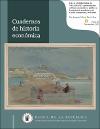DE LA CUMBIAMBA AL VALLENATO: Aproximación cultural, económica y política a la música de acordeón en el Caribe colombiano, 1870-1960.
Cuadernos de Historia Económica; No. 45
Fecha de publicación
2017-11-01Fecha última actualización
2017-11-01Idioma del documento
spaMétricas alternativas
Las opiniones contenidas en el presente documento son responsabilidad exclusiva de los autores y no comprometen al Banco de la República ni a su Junta Directiva. The opinions contained in this document are the sole responsibility of the author and do not commit Banco de la República or its Board of Directors.
Resumen
A partir de los datos aportados por este trabajo se propone que el acordeón llegó
por primera vez a las costas del Caribe colombiano en el año 1870, por lo que el
instrumento está próximo a cumplir 150 años de presencia en el folclor
colombiano. En la década de 1890 se encuentran referencias de los primeros
conjuntos de cumbiamba que se componían de acordeón, caja y guacharaca. En la
última década del siglo XIX y principios del siglo XX surgieron los primeros
intelectuales que discutieron y difundieron la música de acordeón y el folclor
costeño en general. En la segunda mitad del siglo XX el vallenato se convirtió en la
música de mayor auge, primero en el Caribe colombiano y luego en toda
Colombia, desplazando a los otros ritmos costeños como la cumbia y el porro. Su
máximo exponente fue el compositor Rafael Escalona y su principal promotor el
escritor Gabriel García Márquez, quien reconoció las influencias extra literarias de
la música vallenata en sus obras.
Abstract
This document argues that the Accordion first arrived to the Caribbean coast of
Colombia in 1870, which implies that the instrument is about to celebrate 150 years
of influence in the culture of the region. There are references in the decade of 1890
that relate to the first musical groups of cumbiamba, which were integrated by an
accordion, but also with Caja and Guacharaca. The first intellectuals that
commented and spread the music of accordion and the folklore of the Caribbean
region emerged during the last decade of the nineteenth century and the early
twentieth. In the second half of the twentieth century, Vallenato became very
popular. At first in the Caribbean region, but then in all of the country, displacing
other coastal rhythms such as Cumbia and Porro. Its maximum exponent was the
composer Rafael Escalona, and its main promoter the writer Gabriel García
Márquez, who recognized the influence of this music in its work.
Códigos JEL
URI
https://repositorio.banrep.gov.co/handle/20.500.12134/6976https://hdl.handle.net/20.500.12134/6976
https://doi.org/10.32468/chee.45
https://ideas.repec.org/p/bdr/cheedt/45.html
https://ideas.repec.org/p/col/000101/015921.html
Colecciones
Seleccionar año de consulta:
 Esta obra está bajo licencia internacional Creative Commons Reconocimiento-NoComercial 4.0.Este documento ha sido depositado por parte de el(los) autor(es) bajo la siguiente constancia de depósito
Esta obra está bajo licencia internacional Creative Commons Reconocimiento-NoComercial 4.0.Este documento ha sido depositado por parte de el(los) autor(es) bajo la siguiente constancia de depósito

